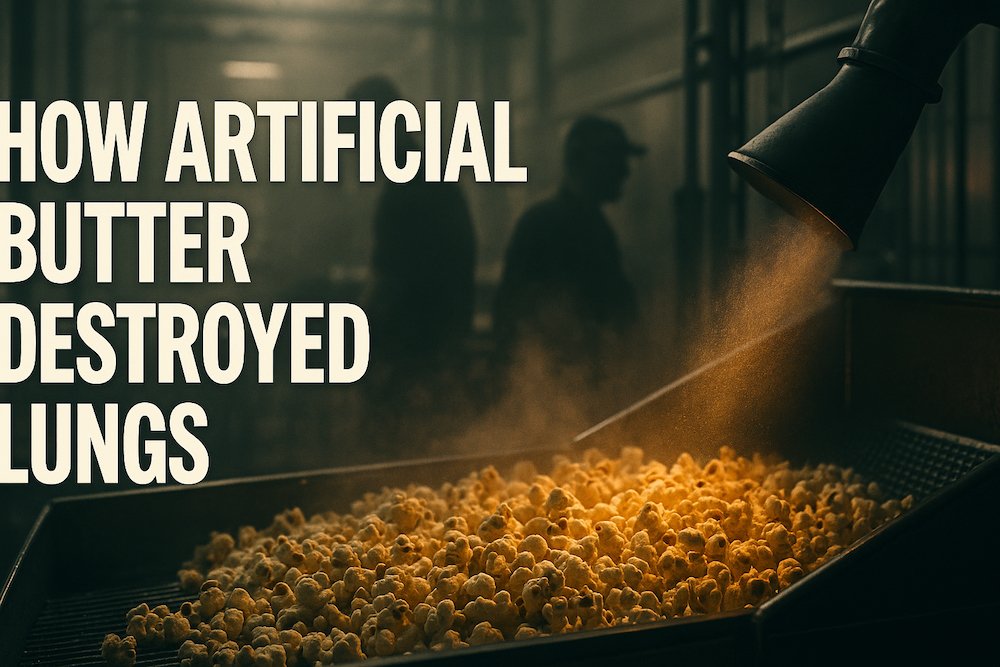For decades, the rich, buttery aroma wafting from microwave popcorn bags seemed like pure magic. That irresistible smell that made your mouth water was created by a single chemical compound: diacetyl. What consumers didn’t know was that this “magic” ingredient was silently destroying the lungs of factory workers and, in some cases, even heavy popcorn consumers.
The Sweet Smell of Profits
Diacetyl, a naturally occurring compound that gives butter its distinctive taste and smell, became the food industry’s golden child in the 1980s. Chemical companies discovered they could synthesize this buttery flavor cheaply and add it to countless products – from microwave popcorn to margarine, baked goods, and even some wines. The artificial version was so potent that just tiny amounts could transform bland foods into buttery delights.
Major food manufacturers embraced diacetyl enthusiastically. Companies like ConAgra, Weaver Popcorn, and Gilster-Mary Lee used it extensively in their popcorn products. The chemical was considered “Generally Recognized as Safe” (GRAS) by the FDA for consumption – a designation that would prove tragically incomplete.
When Workers Started Suffocating
The first warning signs emerged in the late 1990s at flavoring factories across the United States. Workers at plants that manufactured butter flavoring began developing a mysterious, devastating lung disease. Their airways were becoming permanently scarred and narrowed, making breathing increasingly difficult. Many required lung transplants just to survive.
The most notorious case occurred at the Gilster-Mary Lee popcorn plant in Jasper, Missouri. Between 1993 and 2000, more than half of the 117 workers developed severe respiratory problems. Eight workers eventually required lung transplants. The plant’s quality control manager, Eric Peoples, was just 35 years old when he received a double lung transplant after his lungs failed completely.
Medical investigators discovered that these workers were suffering from bronchiolitis obliterans – a rare, irreversible condition where the smallest airways in the lungs become inflamed and scarred. The disease was so strongly associated with butter flavoring factories that doctors began calling it “popcorn lung.”
The Science of Suffocation
Diacetyl’s molecular structure makes it uniquely dangerous when inhaled. Unlike many chemicals that the body can break down and eliminate, diacetyl reacts aggressively with proteins in lung tissue. When workers breathed in diacetyl vapors, the chemical caused severe inflammation in their bronchioles – the tiny air passages that deliver oxygen to the bloodstream.
The body’s immune response to this inflammation creates scar tissue that permanently narrows these airways. As more scar tissue forms, breathing becomes progressively more difficult. The damage is irreversible because lung tissue cannot regenerate once it’s scarred. In severe cases, patients essentially suffocate slowly as their airways close off.
What made diacetyl particularly insidious was its delayed effect. Workers might inhale the vapors for months or years before symptoms appeared. By the time they sought medical help, the damage was often extensive and irreversible.
Legal Battles and Corporate Denial
As the health crisis unfolded, affected workers began filing lawsuits against flavoring manufacturers and popcorn companies. The legal battles revealed disturbing evidence that some companies had known about diacetyl’s dangers for years but failed to warn workers or implement safety measures.
Internal company documents showed that Flavor and Fragrance International had conducted toxicology studies on diacetyl as early as 2001, finding that it caused severe lung damage in laboratory animals. Despite these findings, the company continued selling diacetyl-based flavorings without adequate warnings.
The lawsuits resulted in millions of dollars in settlements. In 2008, International Flavors & Fragrances agreed to pay $16.2 million to settle claims from workers at a California flavoring plant. ConAgra paid $7.5 million to settle a case involving a Colorado consumer who developed popcorn lung from eating multiple bags of microwave popcorn daily for years.
The Regulatory Response
Faced with mounting evidence and legal pressure, the food industry began phasing out diacetyl in the mid-2000s. Most major popcorn manufacturers voluntarily removed it from their products by 2007. However, many companies simply replaced diacetyl with similar compounds like 2,3-pentanedione, which may pose similar health risks.
The Occupational Safety and Health Administration (OSHA) has never set a legal limit for diacetyl exposure in workplaces, though it has issued guidelines recommending that employers minimize worker exposure. The FDA continues to classify diacetyl as GRAS for consumption, meaning it’s still legal in food products, though most manufacturers have moved away from using it.
Current Status: A Global Patchwork
Today, diacetyl regulation varies dramatically worldwide. The European Union has not banned diacetyl but requires strict workplace safety measures when it’s used. Australia has set occupational exposure limits for diacetyl vapors. In the United States, while most major manufacturers have voluntarily eliminated diacetyl from consumer products, it’s still not federally banned.
The diacetyl crisis serves as a stark reminder of how “food safe” doesn’t always mean “worker safe.” While consumers can safely eat small amounts of diacetyl, workers exposed to concentrated vapors paid with their lungs – and sometimes their lives – for our love of buttery flavor.
The next time you smell that artificial butter aroma, remember: behind every “safe” food additive lies a complex story of human cost, corporate responsibility, and the ongoing challenge of protecting workers in our food system.
Want more stories like this?
Subscribe to our YouTube channel Curiosity AI for powerful videos on hidden science, shocking truths, and real-life cases the world tried to forget.
We dive deeper, so you don’t have to dig alone.
Here’s another story that will blow your mind…The Truth About Asbestos: Why This Killer Material Is Still Legal in 2025
